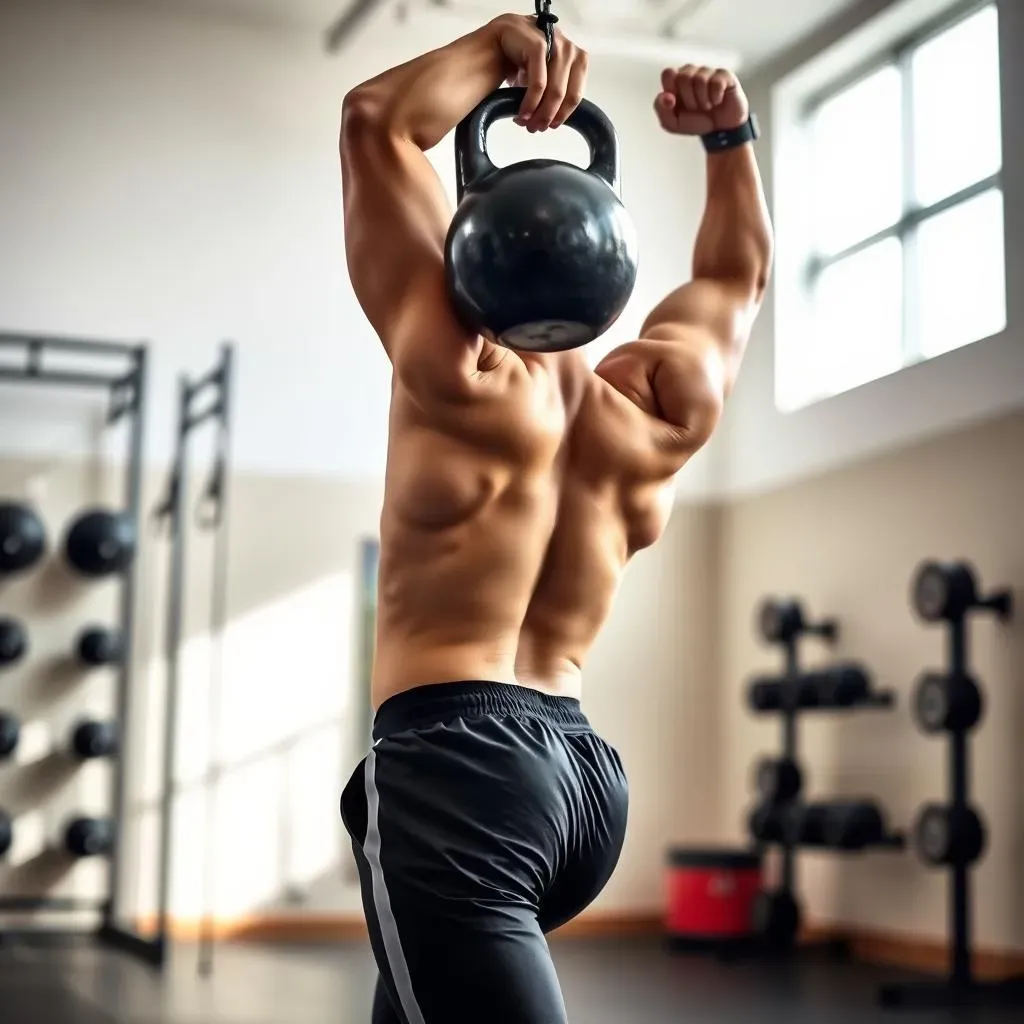Table of Contents
So, you're eyeing those kettlebells, hoping for some serious bicep action? You've probably heard the buzz about kettlebell swings and how they can transform your physique. But let's get real: are those swings actually going to give you the arms of a superhero, or are they more about something else? The question, "do kettlebell swings work biceps," is a common one, and honestly, the answer isn't a straightforward "yes" or "no." This article will cut through the noise and explore what kettlebell swings really do for your body, particularly your biceps. We'll look at how your muscles actually engage during a swing, and what other exercises might be better suited if you're specifically chasing bigger biceps. We’ll also discuss how to ensure that you perform the swing correctly. Let's get started and see what's what.
Kettlebell Swings: The Core Focus, Not Biceps

Kettlebell Swings: The Core Focus, Not Biceps
The Swing's True Purpose
let's clear something up right away. Kettlebell swings are not primarily a bicep exercise. I know, I know, you might've seen some ripped folks swinging them around, and maybe you thought, "That's how I get arms like that!". But the truth is, swings are all about power from your hips and core. Think of it like a pendulum; your arms are just along for the ride. The real work happens in your glutes, hamstrings, and lower back. It's a full-body movement, a powerhouse builder, not a bicep blaster.
The swing's magic lies in the explosive hip hinge. You're not lifting with your arms; you're using your hips to propel the kettlebell forward. Your arms should be fairly relaxed, acting as guides more than anything. If you’re feeling it a lot in your biceps, you’re probably using your arms too much, and not using your hips.
Understanding the Movement
It's easy to get caught up thinking about the kettlebell's path, but focusing on the hinge is key. Imagine you're trying to close a car door with your butt – that's the kind of powerful, explosive movement you want. The kettlebell follows naturally, almost like an extension of your body. Your arms should remain relatively straight during the swing; if you're bending your elbows, you're turning it into something else, and it's not helping your biceps much at all. You might feel some tension in your biceps, but it's more about stabilizing the weight, not actively lifting it. It's like holding a bag of groceries – your biceps are working, but they're not the main muscle doing the work.
Muscle Group | Role in Kettlebell Swing |
|---|---|
Glutes & Hamstrings | Primary power source |
Core | Stabilization and power transfer |
Biceps | Stabilization, minimal work |
Why We Get Confused
So why do people think swings work the biceps? Well, it's probably because you do feel something happening there, especially if you're new to the exercise. The thing is, that feeling is mostly from your biceps contracting to stabilize your arm as the kettlebell moves. It's an isometric contraction, like holding a plank, not a dynamic one, like a bicep curl. You’re not lengthening and shortening the muscle under load, which is what causes growth. It’s more of a "holding on for dear life" feeling than a "bicep pump" feeling. If you are doing it correctly, you won’t feel your biceps getting the work. You will feel it in your legs and glutes.
Biceps Activation During Kettlebell Swings: A Closer Look

Biceps Activation During Kettlebell Swings: A Closer Look
The Stabilizer Role
let's talk biceps and swings a bit more. While they're not the star of the show, your biceps are definitely playing a supporting role. Think of them as the guys holding the ropes on a sailing ship; they're not doing the main pulling, but they are keeping everything steady. During a kettlebell swing, your biceps contract to stabilize your elbow joint. They keep your arm from flailing all over the place as the kettlebell moves. This is called an isometric contraction, where the muscle tenses without changing length. It’s not the kind of work that builds big biceps, but it's important for control and safety.
This stabilization work is crucial because it protects your joints. If your biceps weren't engaged, your elbow could be at risk of injury from the momentum of the kettlebell. So, while they might not be getting a "pump," your biceps are doing valuable work during a swing. The stabilization they provide is super important for the effectiveness of the exercise, and it’s a good example of how muscles work together during movement, even if they aren't the prime movers.
The Impact of Form
Now, here's where things can get a bit tricky. If your form is off, you might unintentionally be turning the swing into more of a bicep exercise than it should be. If you're bending your elbows too much or trying to lift the kettlebell with your arms, you're going to feel it more in your biceps. This is not the goal. You might even get a bit of a bicep pump, but you're also reducing the effectiveness of the exercise and putting yourself at risk of injury. The swing is all about the hip hinge, not the arm lift, so keep those elbows relatively straight and focus on that power from your hips.
Also, the weight you are swinging matters. If you’re swinging a very heavy weight, your biceps may be doing more work than they should be, even if you’re trying to keep them straight. You might be tempted to lift with your arms to help the momentum. If you’re feeling it too much in your biceps, you might need to lighten the load. The goal is to have your glutes and hamstrings do the work, not your biceps. Proper form is not just about preventing injury; it's also about getting the most out of the exercise.
“It’s not about lifting the weight, it’s about moving the weight.” - Some smart person, probably.
Best Ways to Build Biceps: Beyond Kettlebell Swings

Best Ways to Build Biceps: Beyond Kettlebell Swings
Classic Bicep Exercises
so we've established that kettlebell swings aren’t your best bet for huge biceps. If you're serious about building those guns, it's time to bring in the classics. Think bicep curls – dumbbell curls, barbell curls, hammer curls, the whole shebang. These exercises are designed to isolate the bicep muscle, allowing you to work it directly. When you do a curl, you’re actively shortening and lengthening the bicep muscle under load, which is exactly what you need for growth. You can also play around with different grips to hit the biceps from different angles. It's not rocket science; it’s just good, old-fashioned bicep work.
Don't underestimate the power of these fundamental exercises. They've been around for a reason, and they work! You don't need fancy equipment or complex routines to build your biceps. A simple set of dumbbells and a few sets of curls can make a world of difference. It’s all about consistent effort and focusing on proper form. Slow and controlled movements are key; don’t just swing the weight around. This helps ensure that the bicep is doing the work and not momentum.
Pull-ups and Chin-ups: The Compound Kings
Now, let's talk about compound exercises. While curls are great for isolation, pull-ups and chin-ups are fantastic for overall upper body strength and will also hit your biceps pretty hard. The difference between the two is in your grip. A pull-up uses an overhand grip, and a chin-up uses an underhand grip. This underhand grip in chin-ups engages the biceps more directly. These exercises not only work your biceps, but they also hit your back, shoulders, and forearms, making them a great addition to any workout routine. It’s like getting a full upper-body workout with one exercise.
If you can't do a full pull-up or chin-up yet, don't worry! Start with assisted versions or negative reps, where you focus on the lowering portion of the movement. You can also use resistance bands to help you get started. The key is to keep practicing and improving. These compound movements will not only build your biceps but will also give you that all-around strength and functional fitness that you can use in real-world situations. It’s not just about aesthetics; it’s about being strong and capable.
Exercise | Primary Muscle Target | Secondary Muscle Target |
|---|---|---|
Bicep Curls | Biceps | Forearms |
Pull-ups | Back | Biceps, Forearms, Shoulders |
Chin-ups | Biceps | Back, Forearms, Shoulders |
Mix It Up and Listen to Your Body
The best way to build biceps is not to only do one thing. It’s about incorporating a variety of exercises. Don't just stick to curls or just pull-ups. Mix it up to hit your biceps from different angles and keep them guessing. Also, pay attention to how your body responds. If you’re feeling pain, stop and adjust your form or choose a different exercise. It's about finding what works best for you. Some people respond well to heavy weights and low reps, while others do better with lighter weights and high reps. Experiment and find what works for you, and remember that consistency is key. Building muscle takes time, so don’t get discouraged if you don’t see results right away. Just keep working at it, and you’ll get there.
Also, don’t forget about rest and recovery. Your muscles grow when you’re resting, not when you’re working out. Make sure you’re getting enough sleep and eating a balanced diet. It's not just about what you do in the gym; it’s about what you do outside of the gym that makes the biggest difference. Building biceps is a journey, not a destination, so enjoy the process and celebrate the progress you make along the way.
“The only bad workout is the one that didn’t happen.” - Some other smart person, probably.
Wrapping Up: Kettlebell Swings and Biceps
Alright, so we've tackled the burning question: "do kettlebell swings work biceps?" The answer, as we've seen, is a bit nuanced. While swings aren't the secret weapon for bulging biceps, they do engage your arms to some extent. If you're after serious bicep growth, you'll need to incorporate specific exercises like curls and rows. Think of kettlebell swings as a fantastic full-body workout that builds overall strength and power, with a little bit of arm work thrown in. Don't chase the myth of the swing as a bicep builder. Focus on proper form, a balanced routine, and enjoy the benefits of this excellent exercise. And who knows, maybe you'll get a little bicep love along the way, just don't make it the main goal.